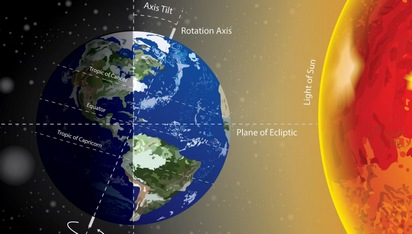
http://www.tankerenemy.com/2023/11/variazione-dellasse-terrestre-e.html?m=1
Secondo un recente studio, condotto da alcuni ricercatori dell’Università di Seul in Corea del Sud, l’asse terrestre, dal 1998 al 2023, si è spostato di quasi un metro, ma è negli ultimi 5 anni che la velocità di spostamento è aumentata, tanto da incidere sul flusso delle correnti a getto (Jet Streams) e, di conseguenza, dei fenomeni meteorologici. La variazione dell’angolo di inclinazione della Terra si è avvertita ovviamente per quanto riguarda l’esposizione rispetto al Sole. Infatti, ad un’attenta osservazione nonché sulla base di verifiche statistiche, risulta che – alle nostre latitudini – il Sole sorge e tramonta con un certo anticipo. Il cambiamento appare piuttosto sensibile e facilmente rilevabile. Alcuni anni fa, gli Inuit avevano notato che la nostra stella non si leva più dove erano abituati a vederla spuntare: è un dato empirico, ma che non può essere ignorato.
L’asse terrestre è attualmente inclinato di 23° 26′ 10.5″ rispetto alla perpendicolare al piano dell’eclittica, il moto apparente che segue il Sole tra le costellazioni. L’entità dell’inclinazione varia ciclicamente tra circa 22° 30′ e circa 24° 30′ con un periodo di 41 000 anni; attualmente è di 23° 26’10.5″ e in diminuzione. Inoltre l’asse terrestre ruota lentamente intorno alla perpendicolare all’eclittica, descrivendo un doppio cono e compiendo un giro ogni 25 800 anni (52″ all’anno). Questo moto è chiamato precessione degli equinozi ed è dovuto alla forza di marea esercitata dalla Luna e dal Sole, un fenomeno che consiste nella levata eliaca del Sole all’equinozio di primavera o d’inverno nella costellazione precedente a quella in cui il Sole leva 26000 anni prima, un fenomeno scoperto da Sir Isaac Newton intorno al 1725. Infine vi sono delle oscillazioni dell’asse di minore entità (circa 20′) e con un periodo più breve (circa 18,6 anni): quest’ultimo moto è detto nutazione.
https://www.mitichestelle.it/astronomia-teorica/precessione-equinozi-asse-terrestre
Giuseppe Veneziano, (Osservatorio Astronomico di Genova)
Come al solito i sostenitori del cambiamento climatico di origine antropica imputano la variazione dell’angolo dell’asse terrestre nonché dei fenomeni meteo estremi alle attività umane ma è esattamente il contrario.
Fonte: Rosario Marcianò, Presidente Comitato Tankeremy Sanremo, Liguria Italia
English translate
VARIATION OF THE EARTH’S AXIS AND CLIMATE CHANGES

According to a recent study, conducted by some researchers from the University of Seoul in South Korea, the earth’s axis has moved by almost one meter from 1998 to 2023, but it is in the last 5 years that the speed of movement has increased, so much so as to affect the flow of jet streams and, consequently, meteorological phenomena. The variation in the angle of inclination of the Earth was obviously felt with regards to the exposure with respect to the Sun. In fact, upon careful observation as well as on the basis of statistical checks, it appears that – at our latitudes – the Sun rises and sets with a certain advance. The change appears rather sensitive and easily detectable. A few years ago, the Inuit noticed that our star no longer rises where they were used to seeing it rise: it is an empirical fact, but one that cannot be ignored.
The Earth’s axis is currently inclined by 23° 26′ 10.5″ with respect to the perpendicular to the plane of the ecliptic, the apparent motion that follows the Sun between the constellations. The amount of inclination varies cyclically between approximately 22° 30′ and approximately 24° 30′ with a period of 41 000 years; it is currently 23° 26’10.5″ and decreasing. Furthermore, the Earth’s axis rotates slowly around the perpendicular to the ecliptic, describing a double cone and completing one revolution every 25,800 years (52″ per year). This motion is called precession of the equinoxes and is due to the tidal force exerted by the Moon and the Sun, a phenomenon that consist in the eliac rising of the Sun in the previous constellation in spring or winter Equinox than 26000 years before, a phenomenon discovered by Sir Isaac Newton around 1725. Finally, there are minor oscillations of the axis (about 20′) and with a shorter period (about 18.6 years): this last motion is called nutation.
As usual, supporters of anthropogenic climate change attribute the variation in the angle of the earth’s axis as well as extreme weather phenomena to human activities but it is exactly the opposite.
Source: Rosario Marcianò, Tankerenemy Committee President Liguria, Italy
Dott. Alessio Brancaccio, tecnico ambientale Università degli Studi di L’Aquila, membro della Fondazione Michele Scarponi Onlus, ideologo e membro del movimento ambientalista Ultima Generazione A22 Network per contrastare il Riscaldamento Globale indotto artificialmente dalla Geoingegneria Solare SRM
